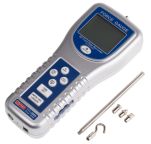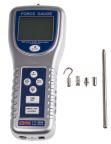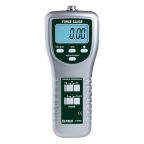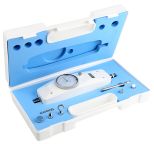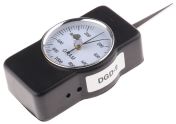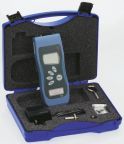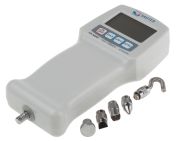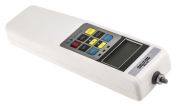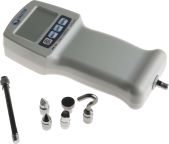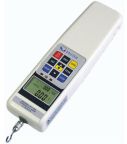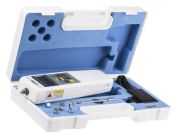Force Gauges
A force gauge is a measurement instrument that detects and quantifies compression and tension forces (commonly referred to as push and pull forces). Force gauges may present measurements in kilograms, pounds, ounces, grams, or Newtons. Some force gauges are handheld, making them highly portable, while others are only meant for stationary use case scenarios only.
Force gauges play a critical role in product development and quality control, helping engineers and technicians to verify that components and assemblies meet the required performance and safety standards. In the automotive industry, force gauges measure the force needed to activate a vehicle's brake pedal and study how compression forces affect car seats in the event of a car crash.
Overloading a force gauge or additional dynamic loads which are unaccounted for can lead to force gauges being damaged or destroyed. When selecting a force measuring instrument, always consider the magnitude of direction of the forces you are studying, to ensure they can be safely absorbed and evaluated.
Types of Force Gauges
Force gauges, also known as force meters, are instruments designed to measure both push and pull forces. They are typically constructed from robust materials to ensure durability and the ability to withstand repeated use.
Mechanical Force Gauges
Mechanical force gauges use springs or levers to measure force—they do not require batteries or a power source to operate. When a force is applied, the spring or lever deflects, moving a needle on an analogue dial to indicate the measurement. While simple and reliable, mechanical force gauges rely on the user’s visual reading, which can introduce errors. This happens when the results are interpreted at an angle, or simply misread.
Digital Force Gauges
Digital force gauges are now far more common and are rapidly becoming the industry standard due to their advanced features and ease of use.
Here's a closer look at digital force gauges:
- Construction: They are built with an electrical load cell, electronics, and a display. The load cell can be integrated internally, which is typical for gauges with smaller measuring ranges. Load cells can also be connected externally to the main unit.
- Accuracy and usability: Digital force gauges are highly accurate and generally easy to operate. With a digital force gauge, you can get access to data storage, USB output and as well as peak hold or real-time modes on your instrument.
- Measurement units: Basic models may display data in only one unit of measurement (e.g. Newtons). More advanced digital force gauges can provide results in a range of measurement units.
- Versatility: Many force gauges come with extension rods and adapters that enable various types of testing setups.
- Portable vs. stationary units: While it's common for digital force gauges to be handheld, they can also be securely mounted to test stands for more stable and precise measurements.
How Do Force Gauges Work?
A force gauge is a measuring instrument used to determine the applied compression (push) or stretching force (pull). Force gauges are also able to define how much torque is needed to accomplish a task. Force measuring instruments are essential for designing items such as child-resistant lids on medicinal containers and cortical bone screws.
Mechanical force gauges use either a spring or lever to measure force.
- When the lever or spring is deformed due to the force applied, the needle on the analogue dial moves accordingly, displaying the measurements in real time. The drawback of mechanical force gauges is that readings are only as accurate as the human eye, which can be prone to errors.
Meanwhile, digital force gauges use load cells or strain gauge transducers to determine force.
- Applied force is converted into electrical signals, which appear on a digital display. Unlike mechanical force gauges, their use case scenario can be widened with the addition of the relevant sensors. When it comes to accuracy, digital force gauges are more reliable than mechanical ones, since their direct output of data eliminates human error.
With digital force gauges, measuring and retaining specific data is easier than ever. Some force gauges are even able to pick up peak and real-time forces.
Choosing the Right Force Gauge for Your Application
Picking the right tool for the right task requires careful consideration of a multitude of factors. They are:
- What type of force is being measured? Not every force gauge is suited for measuring tension, compression, flexure and torque. Do check if your force gauge is capable of displaying the unit of measurement you require, whether it's grams, kilograms, pounds, and/or Newtons. For specific force measurements, check with your instrument supplier for recommendations.
- What is the force measuring range required? A simply spring scale will suffice when measuring minimal force. Wider measuring ranges can be achieved with a hydraulic force gauge, which is also a mechanical force meter. As for multi-purpose digital force gauges, an adapator or pre-programmed measurement conversions can expand their range.
- What is the degree of accuracy needed? A digital force gauge is a lot more accurate than a hydraulic force gauge. This is due to the need for constant calibration and the possibility of a leak in the hydraulic system. Check for the measuring accuracy of your instrument to ensure it is within acceptable range.
- What environment will your force measuring instrument be utilised in? A handheld force gauge can be used for collecting readings for quality assurance purposes. If you are conducting repeat tests, use a stationary test stand with your force gauge for more precise readings.
Common Industries Using Force Gauges
Force measuring instruments are widely used in various industries. Whether mechanical or digital, you will find force gauges being used to measure product performance in fields as varied as the automotive, medical, and textile industries. They are used in all stages of creating a product, from design, to manufacturing and ultimately production and assembly.
- Automotive: A force gauge made with resistive load cells may be used to measure forces on a seat belt, in order to design an effective product that protects passengers and drivers in the event of an accident.
- Medical: Verifying tensile strength of sutures or tubing can be done with tension force gauges to make quality medical products that save or enhance lives.
- Electronics: Force gauges are also essential for designing everyday products like buttons on a switchboard, inside a car or on a machine. A carefully calibrated actuation force ensures the button won’t be too easily triggered. The tensile strength of tensioned cables with transmission or load-bearing purposes are also determined by force gauges.
- Packaging: Force gauges can also test for "peeling" strength, in order to determine how much force is needed to remove a layer from a substrate by pulling. This can be expiration date labels on perishables, or seals that keep medicine in a stable state.
The Leading Supplier and Distributor of Force Gauges in Malaysia
RS is your source for high-quality force gauges used in testing, manufacturing and quality control. We stock key products from industry leaders like Sauter, Extech, and Mecmesin. Our selection includes various force measuring instruments at competitive prices, ensuring you will find the right tool for your application.
Looking for other Testing and Measurement products? We also carry calibration weights, ESD testers, anemometers and other instruments designed for reliable and accurate measurement. For more details on how to order from RS, delivery services, and delivery fees, please refer to our delivery page.
Popular Searches
Related links
- Digital Force Gauge
- Sauter FA 200 Force Gauge Resolution: 1 N
- Sauter FK 500 Force Gauge 1000Hz Resolution: 0.2 N
- Sauter FH 200 Force Gauge 2000Hz RS232 Resolution: 0.1 N
- RS PRO Force Gauge RS232 Range: 49.03N
- RS PRO Force Gauge RS232 Range: 196N
- Mecmesin 860-021 Force Gauge 500Hz RS232 Resolution: 0.05 N
- High Capacity Force Gauge
